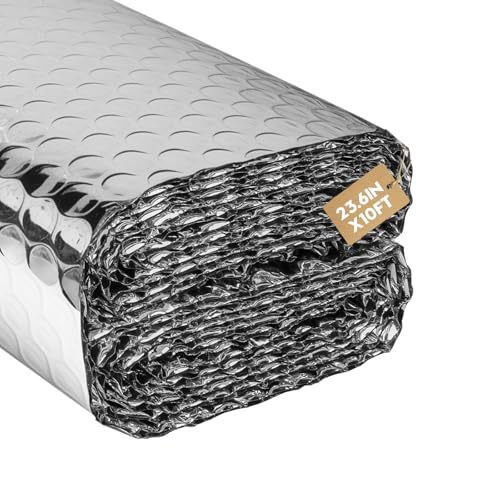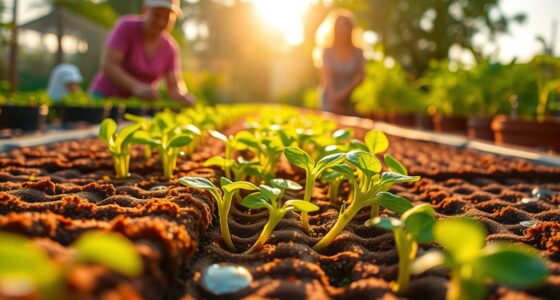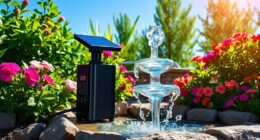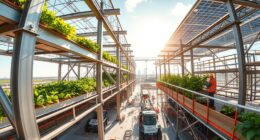When it comes to maximizing temperature control in greenhouses, I've found some outstanding options. The 10 x 26 FT Clear Greenhouse Plastic Sheeting and the DGSL Double Reflective Bubble Foil Insulation Foam provide excellent insulation properties. Don't overlook Mylar films for light reflection, and polycarbonate panels for durability and heat retention. Each material has its unique benefits, helping you create an ideal growing environment. Stick around, and I'll share more about specific products and their advantages!
Key Takeaways
- Clear greenhouse plastic sheeting offers high light transmission and warmth retention, essential for seed germination and plant growth.
- Reflective insulation materials, like Mylar films, can reflect up to 95% of light, enhancing temperature control and promoting plant health.
- Double reflective insulation rolls combine aluminum foil with bubble film, effectively regulating temperatures in both summer and winter for optimal greenhouse conditions.
- Polycarbonate panels provide durable, shatterproof insulation with excellent heat retention, suitable for versatile greenhouse applications.
- Lightweight insulation options with easy customization and reusable features enhance flexibility for various greenhouse sizes and seasonal adjustments.
10 x 26 FT Clear Greenhouse Plastic Sheeting, 6 Mil Polyethylene Film
When it comes to maximizing plant growth in your greenhouse, the 10 x 26 FT Clear Greenhouse Plastic Sheeting, made from durable 6 mil polyethylene, is an excellent choice. Its high-quality, flexible material offers up to 90% light transmission, ensuring your plants receive ample sunlight for robust growth. Plus, it retains warmth, which is perfect for seed germination. The drip-proof design prevents water from harming your plants, while its heavy-duty construction withstands harsh weather conditions. I love how easy it is to handle, making it a versatile option for various applications, from DIY greenhouses to flower planting.
Best For: Gardeners and hobbyists looking for a durable and efficient greenhouse solution to promote plant growth and protect against adverse weather conditions.
Pros:
- High light transmission (up to 90%) promotes healthy plant growth and seed germination.
- Durable 6 mil polyethylene is tear and puncture resistant, ensuring long-lasting use in various weather conditions.
- Drip-proof design minimizes the risk of water damage to plants, enhancing overall plant health.
Cons:
- Some users report brittleness after prolonged exposure, which may affect durability over time.
- Cost-saving measures might lead to long-term expenses due to potential degradation of the material.
- Limited UV resistance may result in aging over time with constant sunlight exposure.
DGSL Double Reflective Bubble Foil Insulation Foam (23.6 in X 10 FT)
For greenhouse enthusiasts seeking an effective solution to maintain ideal temperatures, the DGSL Double Reflective Bubble Foil Insulation Foam stands out with its impressive heat control capabilities. This lightweight material, measuring 23.6 inches by 10 feet, reflects sunlight, helping to keep your greenhouse cool in summer and warm in winter. Users often report temperature reductions of up to 10 degrees compared to the outside. Installation is a breeze with the included self-adhesive pads, allowing for easy customization. While some may face adhesion issues, the overall benefits in temperature regulation make it a solid choice for greenhouse insulation.
Best For: Greenhouse enthusiasts looking for an effective insulation solution to regulate temperatures efficiently.
Pros:
- Lightweight and easy to cut, making installation simple and customizable.
- Reflective surface effectively blocks sunlight, promoting temperature control in varying climates.
- Users report significant temperature reductions, enhancing comfort in greenhouses.
Cons:
- Some users experience issues with the adhesion of self-adhesive pads, requiring alternative securing methods.
- Durability concerns under windy conditions have been noted by a few users.
INSULATION MARKETPLACE SmartSHIELD Reflective Insulation Roll
The SmartSHIELD Reflective Insulation Roll stands out as an ideal choice for greenhouse enthusiasts who prioritize energy efficiency and temperature control. It reflects 95% of radiant energy, making it an effective barrier against heat. I love that it functions as a vapor barrier, remaining unaffected by moisture. Plus, it's lightweight and easy to cut, which makes installation a breeze. I've noticed a significant temperature increase in insulated areas, perfect for starting seeds. Though it's versatile for various uses, I do take care when handling it to avoid tearing. Overall, it's a fantastic option for anyone looking to enhance their greenhouse experience!
Best For: Greenhouse enthusiasts seeking effective energy efficiency and temperature control in their growing spaces.
Pros:
- Effective thermal insulation that blocks radiant heat, enhancing temperature stability.
- Lightweight and easy to cut for customized installation in various applications.
- Functions as a vapor barrier, remaining unaffected by moisture and humidity.
Cons:
- Limited size options may not be suitable for larger areas requiring insulation.
- Requires careful handling to avoid tearing the foil layer during installation.
Frost King P1025/6W Polyethylene Sheeting, 10 x 25 x 6 mil., Clear
Frost King P1025/6W Polyethylene Sheeting stands out as an excellent choice for greenhouse insulation due to its 6 mil thickness and waterproof properties. Measuring 10 x 25 feet, it's perfect for various applications, such as protecting plants from harsh weather. I appreciate its durability and versatile nature, which makes it ideal for temporary enclosures and even as a vapor barrier. While some have noted it's semi-transparent rather than fully clear, its effectiveness in retaining heat is undeniable. Plus, with a solid customer rating, it's a reliable option to help maintain a stable temperature in my greenhouse.
Best For: Those seeking a durable and versatile solution for greenhouse insulation and temporary enclosures.
Pros:
- Durable 6 mil thickness provides excellent protection and insulation.
- Waterproof material is ideal for outdoor use and plant protection.
- Versatile applications, including as a vapor barrier and drop cloth.
Cons:
- Some users reported it is semi-transparent rather than fully clear as described.
- May arrive folded rather than rolled, affecting ease of application.
- Limited ultraviolet light protection.
Plant Growth Mylar Films for Greenhouse Covering and Thermal Insulation
Plant Growth Mylar Films stand out as an excellent choice for greenhouse covering and thermal insulation, especially for gardeners looking to maximize plant growth. Made from high-quality VMPET with dual-sided mylar, these films reflect 95% of light, enhancing your plants' growth potential. I love their versatility; they're not only durable and waterproof but also reusable, making them perfect for various applications. Whether I'm lining my greenhouse or using them as window coverings, they help control temperatures effectively. Plus, they retain up to 90% of body heat in emergencies, proving their worth beyond just gardening. They're definitely a smart investment!
Best For: Gardeners and outdoor enthusiasts looking to enhance plant growth and provide thermal insulation in greenhouses and emergency situations.
Pros:
- Reflects 95% of light to significantly boost plant growth.
- Durable, waterproof, and reusable, making it a cost-effective choice for various applications.
- Retains up to 90% of body heat, useful for thermal insulation in emergencies.
Cons:
- Some users report it may be slightly see-through.
- Can rip easily if not handled carefully.
- Requires proper storage to maintain its effectiveness and durability.
Reflective Insulation Roll (23.6inch x 10Ft)
If you're looking for an efficient way to regulate temperatures in your greenhouse, the Reflective Insulation Roll (23.6in x 10Ft) could be your best bet. This double bubble reflective aluminum foil wrap effectively blocks heat during summer and cold air in winter, maintaining an ideal environment for your plants. Weighing just 12 ounces, it's easy to install and can be cut to fit any space. The scratch-resistant surface enhances durability, while its versatility allows use in various applications, from windows to RVs. With a 4.6-star rating, many users rave about its effectiveness and ease of use.
Best For: This product is best for individuals seeking an efficient and versatile insulation solution for temperature regulation in various spaces, such as greenhouses, RVs, and homes.
Pros:
- High Performance: Effectively blocks heat in summer and cold air in winter, maintaining optimal indoor temperatures.
- Durable Design: Scratch-resistant surface enhances longevity and ensures it withstands long-term use.
- Easy Installation: Can be cut to any shape or size and installed with various adhesive options for convenience.
Cons:
- Creasing During Shipping: Folded for shipping may result in creases that require time to disappear after installation.
- Limited Color Options: Available only in silver, which may not suit all aesthetic preferences.
- Requires Additional Adhesives: Adhesives are not included, necessitating separate purchase for installation.
Plant Growth Mylar Films for Greenhouse Covering (6 Pieces)
For anyone looking to enhance their greenhouse's efficiency, the Plant Growth Mylar Films are an excellent choice. These lightweight, durable films provide exceptional light reflection, bouncing back 95% of light to guarantee even distribution for your plants. At 82.6 x 51.2 inches, they're easy to cut and install, making them versatile for various applications. Users rave about improved plant growth and the films' ability to enhance solar radiation transmission. I recommend securing them with painter's tape for a hassle-free installation. Just handle them carefully, as the thin material can tear easily. These films are a game-changer for any greenhouse!
Best For: Gardeners and greenhouse owners looking to improve plant growth through efficient light reflection.
Pros:
- High light reflection: Reflects 95% of light, promoting even distribution for optimal plant growth.
- Versatile applications: Can be used for various purposes beyond gardening, including emergency blankets and photography reflectors.
- User-friendly installation: Easy to cut and secure with tape, making setup hassle-free.
Cons:
- Thin material: Requires careful handling to prevent tearing during installation and use.
- Limited durability: May need multiple layers for effective light blockage, which can increase installation time.
- Size constraint: The dimensions may not fit all greenhouse setups without modification.
Double Reflective Insulation Roll (23.6 X10)
The Double Reflective Insulation Roll (23.6 X10) stands out as an ideal choice for greenhouse enthusiasts looking to optimize temperature control. This product combines double-sided aluminum foil with vacuum-sealed polyethylene bubble film, effectively reducing heat transfer. I appreciate how it keeps my greenhouse warm in winter and cool in summer. The roll's circular surface design enhances reflectivity, even under strong sunlight. Installation is a breeze; it comes with 60 pieces of double-sided tape for secure attachment. Plus, with an average rating of 4.6 stars from satisfied users, it's clear this insulation is both effective and user-friendly.
Best For: Those looking to enhance temperature control in greenhouses, RVs, garages, and various indoor spaces.
Pros:
- Excellent insulation performance, effectively reducing heat transfer for year-round comfort.
- Easy installation with included double-sided tape, allowing for quick and secure attachment.
- High customer satisfaction with an average rating of 4.6 stars, indicating effectiveness and user-friendliness.
Cons:
- Limited to a fixed size of 23.6 inches x 10 feet, which may not fit all applications without cutting.
- Requires careful cutting for custom sizes, which may be challenging for some users.
- Performance may vary based on installation quality and environmental conditions.
Large Bubble 24-Inches Wide (65-Feet)
When it comes to insulating your greenhouse effectively, the Large Bubble Roll, measuring 24 inches wide and 65 feet long, stands out as an excellent choice. Made from durable polyethylene, this clear insulation is lightweight at only 2.5 pounds, making it easy to handle. With a stellar customer rating of 4.6 out of 5 stars, it's proven to increase temperatures and reduce heating costs in greenhouses. Plus, it's versatile enough for other uses, like wrapping fragile items. If you need a reliable insulation option, I highly recommend considering this product. It could make a significant difference in your greenhouse's climate control.
Best For: Those looking to insulate greenhouses, protect fragile items during moving, or needing versatile packing solutions.
Pros:
- Lightweight and easy to handle at only 2.5 pounds.
- High customer satisfaction with a rating of 4.6 out of 5 stars.
- Versatile use for both insulation and wrapping fragile items.
Cons:
- Limited to a single unit count, which may require multiple purchases for larger projects.
- Only available in a clear color, which may not suit all preferences.
- May not provide the highest level of insulation compared to thicker alternatives.
Hotop 6 Pcs Polycarbonate Greenhouse Panels
Looking for an effective insulation solution for your greenhouse? I found the Hotop 6 Pcs Polycarbonate Greenhouse Panels to be an excellent choice. These durable, double-layer panels measure 4 x 2 x 0.24 inches and weigh just under 10 pounds, making them easy to handle. Their robust design protects against breaking, while effectively keeping heat and UV rays out. I love that they're cuttable for customization, allowing me to adapt them to different greenhouse shapes. With a solid customer rating of 4.5 stars, many users praise their versatility for various projects beyond greenhouses. This product is worth considering!
Best For: Gardeners and DIY enthusiasts looking for versatile and durable insulation solutions for greenhouses and other outdoor projects.
Pros:
- Durable construction: Polycarbonate panels are resistant to breaking and provide reliable protection from the elements.
- Customizable: The panels can be easily cut to fit different greenhouse shapes and sizes.
- Versatile applications: Suitable for various uses, including garden fencing, swimming pool roofs, and homemade projects.
Cons:
- Softer material: Some users may find the material softer compared to traditional polycarbonate, which could affect durability in specific applications.
- Weight: At nearly 10 pounds, the panels may be heavier than other options, making them slightly more difficult to handle for larger projects.
- Limited warranty information: Customers need to check the product link for specific warranty details, which may not be immediately clear.
Tatuo 6 Pack Polycarbonate Greenhouse Panels
For gardeners seeking effective insulation solutions, the Tatuo 6 Pack Polycarbonate Greenhouse Panels stand out with their hollow honeycomb structure designed for ideal heat retention. I love how these lightweight panels, measuring 48 x 24 inches, are easy to install using ordinary tools. Their 0.16-inch thickness guarantees durability and excellent insulation, keeping my greenhouse warm in winter and cool in summer. Plus, they're shatterproof and can be cut to fit specific dimensions. While they work well for various applications, I've found they may need reinforcement in windy conditions. Overall, they're a fantastic choice for optimizing greenhouse temperatures!
Best For: Gardeners looking for effective insulation solutions for their greenhouses and small outdoor projects.
Pros:
- Lightweight and easy to install with ordinary tools.
- Durable 0.16-inch thick panels provide excellent insulation for temperature control.
- Versatile applications beyond greenhouses, including use in swimming pool roofs and outdoor canopies.
Cons:
- May require reinforcement in windy conditions due to their flexible nature.
- Width may need trimming for specific greenhouse frames.
- Suitable for small projects, but may not last long under extreme conditions.
Radiant Barrier Reflective Foil Insulation (500sqft Roll)
Radiant Barrier Reflective Foil Insulation is an excellent choice for greenhouse enthusiasts seeking to enhance temperature control and energy efficiency. This 500 sqft roll features a durable, two-sided aluminum metallized film, making it waterproof and weatherproof. I've found it easy to cut and staple, ensuring a snug fit in my greenhouse. Users rave about its effectiveness, reporting energy bill reductions up to $100. Plus, it's perforated to prevent moisture buildup. With a solid fire rating and a 30-day return guarantee through Amazon, I feel confident recommending this insulation for any greenhouse project. Give it a try—you won't regret it!
Best For: Greenhouse enthusiasts looking for effective temperature control and energy efficiency solutions.
Pros:
- Durable two-sided aluminum metallized film provides excellent insulation and weather resistance.
- Users have reported significant energy savings, with reductions in energy bills of up to $100.
- Easy to install and cut, making it suitable for DIY projects.
Cons:
- Some users have expressed concerns about the material tearing during installation.
- Effectiveness may vary based on specific greenhouse conditions and configurations.
- Limited to a roll size of 500 sqft, which may not be sufficient for larger projects.
Plastic Sheeting (10 x 25, 6 Mil) – UV Protection Polyethylene Film
When it comes to insulating your greenhouse effectively, the Plastic Sheeting (10 x 25, 6 Mil) with UV protection is a standout choice for gardeners and hobbyists alike. This heavy-duty polyethylene film covers 250 square feet and offers impressive durability, withstanding rain, cold, and heat. I've found it tear-resistant and thick, making it perfect for various applications—from protecting floors to enclosing plants during chilly weather. Users rave about its ease of use and functionality, often comparing it favorably to pricier alternatives. Plus, it's well-packaged, ensuring great value for the amount of plastic you receive. You won't be disappointed!
Best For: Gardeners and hobbyists looking for a durable and versatile solution to insulate greenhouses and protect plants during cold weather.
Pros:
- Heavy-duty and tear-resistant material suitable for various applications.
- Provides effective UV protection while withstanding harsh weather conditions.
- Well-packaged and offers great value for the amount of plastic received.
Cons:
- Creases may occur from folding during packaging, requiring tension to lay flat.
- Limited to a specific size (10 x 25 feet), which may not suit all projects.
- Some users may find it less effective compared to specialized greenhouse coverings.
Polycarbonate Greenhouse Panels (32.8Ft x 3.28Ft)
Polycarbonate greenhouse panels (32.8Ft x 3.28Ft) stand out as an exceptional choice for gardeners seeking durability and efficiency. I love how these panels feature a double-layer design, which minimizes dust collection while providing superior protection for my plants. With an impressive 85% light transmittance, they guarantee maximum sunlight exposure, enhancing growth. Plus, their remarkable adaptability means they resist extreme temperatures and UV light, making them versatile for various applications. Although some users mentioned installation challenges, the overall positive feedback speaks volumes about their quality. I'm confident these panels will help create a thriving greenhouse environment.
Best For: Gardeners and DIY enthusiasts looking for durable and efficient greenhouse solutions to enhance plant growth and withstand various environmental conditions.
Pros:
- Outstanding light transmittance of 85% ensures maximum sunlight exposure for optimal plant growth.
- Double-layer design minimizes dust collection and provides superior protection against the elements.
- Versatile adaptability allows for use in various applications, including sunrooms, patios, and enclosures.
Cons:
- Some users reported installation challenges, which may require additional effort or assistance.
- Feedback indicates occasional edge tears, which could impact the overall durability of the panels.
- May not be suitable for extreme weather conditions without proper reinforcement or installation techniques.
Factors to Consider When Choosing Insulation for Greenhouses

When I think about choosing insulation for my greenhouse, several key factors come to mind. I need to evaluate material durability, insulation efficiency, and how well it regulates temperature. It's also important to think about light transmission and how easy it is to install.
Material Durability and Resistance
Choosing the right insulation for your greenhouse can greatly impact its longevity and efficiency. I always recommend looking for materials that are tear and puncture resistant, like polyethylene sheeting with a thickness of at least 6 mil. This enhances durability against environmental stressors. UV resistance is also essential; it prevents aging and degradation from sunlight exposure, ensuring the insulation remains effective. Polycarbonate panels are another great option, offering high impact resistance against harsh weather. Additionally, choose insulation that can withstand varying temperatures and moisture levels to avoid warping. Finally, consider lightweight and flexible materials for ease of installation and customization. This way, you can adapt your insulation to fit your specific greenhouse design effectively.
Insulation Performance Efficiency
Three key factors can greatly impact insulation performance efficiency in greenhouses. First, you'll want materials that reflect up to 95% of radiant energy. This reflection helps maintain ideal temperatures, which is essential for plant growth. Second, effective insulation can stabilize temperatures, with reports showing increases from 50°F to 65°F in insulated areas, enhancing seed starting and plant health. Finally, consider double-sided reflective insulation, which blocks heat in summer and retains warmth in winter, ensuring a consistent growing environment year-round. Additionally, using insulation with a vapor barrier prevents moisture issues, critical for the health and longevity of your greenhouse structures. These factors together greatly improve comfort and energy efficiency in your greenhouse.
Light Transmission and Reflection
How can we guarantee that our greenhouse insulation supports ideal plant growth? First, we need to focus on light transmission. I look for materials that allow up to 90% light transmission, as this ensures our plants receive the sunlight they need. Additionally, using reflective materials can enhance light distribution, reflecting up to 95% of light for even illumination. Dual-sided reflective films are a smart choice, maximizing light reflection and improving solar radiation efficiency. However, it's essential to strike a balance between light transmission and thermal insulation. Proper insulation not only conserves heat but also helps maintain consistent internal temperatures. By considering these factors, I can create a thriving environment for my plants throughout the seasons.
Temperature Regulation Capabilities
While evaluating insulation options for my greenhouse, I focus on temperature regulation capabilities to guarantee my plants thrive. Effective insulation reduces heat loss or gain, helping maintain ideal temperatures for plant growth. I've found that some products can increase indoor temperatures by up to 15°F compared to the outside. Reflective materials are particularly useful, blocking up to 95% of radiant energy and guaranteeing heat control in both hot and cold weather. It's essential that the insulation offers high light transmission, ideally over 90%, to allow sunlight while retaining warmth. I also consider types like bubble foil that act as a vapor barrier, preventing moisture buildup. Finally, I prefer durable, weather-resistant insulation to guarantee consistent temperature regulation throughout the seasons.
Installation Ease and Flexibility
After ensuring effective temperature regulation in my greenhouse, I turn my attention to installation ease and flexibility when selecting insulation. I look for materials that I can easily cut and customize to fit my greenhouse dimensions, which enhances the installation process. Lightweight options simplify handling, allowing for quicker setups and adjustments. I appreciate products with adhesive backing or self-adhesive pads; they make installation straightforward and reduce the need for extra tools. Additionally, I prefer insulation that can be easily unfolded and secured with tape or clamps, offering versatility in installation methods. I also consider materials designed to be re-used or repositioned, as this adaptability is essential for adjusting to different seasons or greenhouse configurations.
Cost-Effectiveness and Value
When I consider insulation for my greenhouse, cost-effectiveness and overall value are vital factors. I evaluate both the initial purchase price and the potential long-term energy savings. Effective insulation can greatly reduce heating and cooling costs, making durable materials like double-sided reflective insulation worth the investment. I've found that thicker materials, such as 6 mil polyethylene sheeting, resist environmental factors better, enhancing longevity. Additionally, I look for insulation with high light transmission, like reflective films allowing up to 95% light, to guarantee ideal plant growth while using energy efficiently. I've noticed that cheaper options often lead to higher long-term costs due to degradation, so balancing upfront costs with expected lifespan and performance is essential for me.
Versatile Application Uses
Choosing the right insulation for my greenhouse goes beyond just temperature control; it also involves considering how versatile the materials can be. Insulation can greatly reduce heat loss or gain, which is essential for healthy plant growth. I love that reflective insulation can block up to 95% of radiant energy, keeping my greenhouse comfortable in both hot and cold weather. Plus, I can use insulation for windows, roofs, and even garage doors, enhancing energy efficiency across different structures. Some materials double as thermal barriers and soundproofing solutions, great for high-noise areas. With easy installation and customization options, I can tailor the insulation to fit my greenhouse's unique size and shape, maximizing its effectiveness.
Environmental Considerations and Safety
While selecting insulation for my greenhouse, I always prioritize materials that are non-toxic and free from harmful chemicals. This guarantees a safe environment for both my plants and my health. I also look for UV-resistant materials; they help prevent degradation and extend the insulation's lifespan, which reduces waste. Effective temperature regulation is key to energy efficiency, lowering my overall carbon footprint. I prefer lightweight and durable options, as they minimize environmental impact during transport and installation. Additionally, I choose materials that are recyclable, allowing for responsible disposal and reducing landfill contributions. By considering these factors, I feel confident that my greenhouse remains sustainable and safe for the ecosystem.
Frequently Asked Questions
How Do I Properly Install Insulation in My Greenhouse?
When I install insulation in my greenhouse, I start by measuring the walls and ceiling to guarantee I get the right amount of material. I then choose a suitable insulation type, like foam boards or bubble wrap. After cutting the insulation to size, I secure it with adhesive or tape, making certain there are no gaps. Finally, I double-check for leaks and adjust as needed to keep my greenhouse cozy and efficient.
What Are the Benefits of Using Reflective Insulation in Greenhouses?
Using reflective insulation in my greenhouse has made a noticeable difference. It helps to redirect sunlight, maximizing light exposure while minimizing heat loss at night. I've found that it keeps the temperatures more stable, which is essential for plant growth. Plus, it's lightweight and easy to install, making my greenhouse more energy-efficient. Overall, I've seen healthier plants and reduced energy costs, and I wouldn't want to go without it now.
Can I Combine Different Insulation Materials for Better Results?
Sure, I once combined bubble wrap with reflective foil in my greenhouse. It worked wonders! You can definitely combine different insulation materials for better results. Each type brings its strengths—like reflecting heat or trapping air. By layering them, I noticed improved temperature regulation and energy savings. Just make certain they're compatible and don't trap moisture, which can harm your plants. Experimenting with combinations can lead to the perfect setup for your needs!
How Does Insulation Impact Humidity Levels Inside a Greenhouse?
Insulation plays an essential role in regulating humidity levels inside a greenhouse. I've noticed that proper insulation helps maintain moisture by reducing temperature fluctuations, which can lead to condensation. When it's well-insulated, the air retains humidity better, creating a more stable environment for my plants. If I combine insulation materials effectively, I can enhance both temperature control and humidity, ensuring my greenhouse stays healthy and productive throughout the year.
What Maintenance Is Required for Greenhouse Insulation Materials?
Maintaining my greenhouse insulation feels like tending a garden; it requires regular care to flourish. I check for wear and tear, ensuring no gaps let the cold creep in. Cleaning the surfaces keeps the light flowing, while inspecting for mold or pests helps avoid problems down the line. I also replace any damaged materials promptly, nurturing the environment I've created. With consistent attention, my greenhouse thrives, much like the plants within.
Conclusion
In the world of greenhouse gardening, insulation is like a warm hug on a chilly day. Just as a skilled tailor crafts the perfect coat to keep you cozy, choosing the right insulation guarantees your plants thrive in a comfortable environment. Each option, from bubble foil to polycarbonate panels, plays its part in this nurturing symphony. So, embrace these insulation choices, and watch your greenhouse bloom, even when the cold winds blow outside. Your garden deserves it!

























